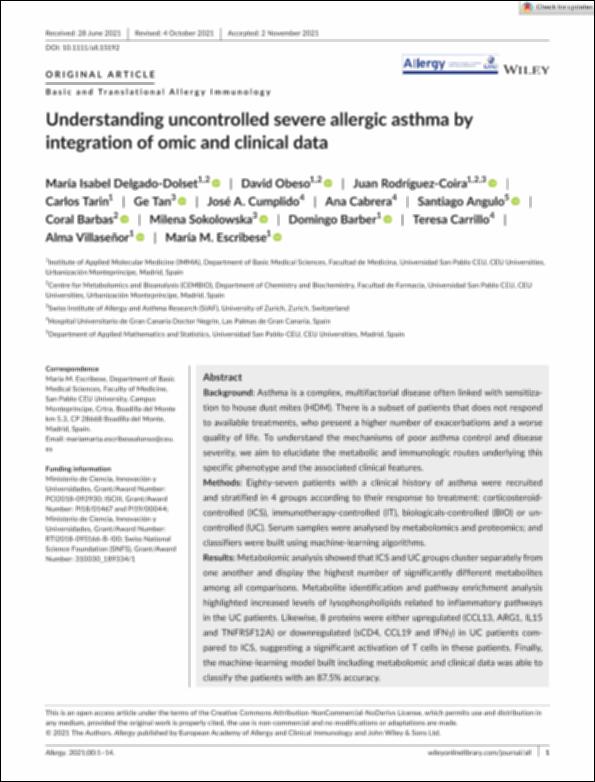Por favor, use este identificador para citar o enlazar este ítem:
http://hdl.handle.net/10637/13376Understanding uncontrolled severe allergic asthma by integration of omic and clinical data.
| Título : | Understanding uncontrolled severe allergic asthma by integration of omic and clinical data. |
| Autor : | Delgado Dolset, María Isabel Obeso Montero, David Escribese Alonso, María Marta Barber Hernández, Domingo Villaseñor Solis, Alma Cristina Barbas Arribas, Coral. Rodríguez Coira Villanueva, Juan Tarin, Carlos Tan, Ge Cumplido, José A. Cabrera, Ana Angulo Díaz-Parreño, Santiago Sokolowska, Milena Carrillo, Teresa |
| Materias: | Allergy.; Asthma.; Machine learning.; Metabolomics.; Proteomics. |
| Resumen : | Background: Asthma is a complex, multifactorial disease often linked with sensitization to house dust mites (HDM). There is a subset of patients that does not respond to available treatments, who present a higher number of exacerbations and a worse quality of life. To understand the mechanisms of poor asthma control and disease severity, we aim to elucidate the metabolic and immunologic routes underlying this specific phenotype and the associated clinical features. Methods: Eighty-seven patients with a clinical history of asthma were recruited and stratified in 4 groups according to their response to treatment: corticosteroid-controlled (ICS), immunotherapy-controlled (IT), biologicals-controlled (BIO) or uncontrolled (UC). Serum samples were analysed by metabolomics and proteomics; and classifiers were built using machine-learning algorithms. Results: Metabolomic analysis showed that ICS and UC groups cluster separately from one another and display the highest number of significantly different metabolites among all comparisons. Metabolite identification and pathway enrichment analysis highlighted increased levels of lysophospholipids related to inflammatory pathways in the UC patients. Likewise, 8 proteins were either upregulated (CCL13, ARG1, IL15 and TNFRSF12A) or downregulated (sCD4, CCL19 and IFNγ) in UC patients compared to ICS, suggesting a significant activation of T cells in these patients. Finally, the machine-learning model built including metabolomic and clinical data was able to classify the patients with an 87.5% accuracy. Conclusions: UC patients display a unique fingerprint characterized by inflammatory-related metabolites and proteins, suggesting a pro-inflammatory environment. Moreover, the integration of clinical and experimental data led to a deeper understanding of the mechanisms underlying UC phenotype. |
| Descripción : | En: Allergy e-ISSN:1398-9995, 2021, nov. 28, 14 pp |
| URI : | http://hdl.handle.net/10637/13376 |
| Derechos: | http://creativecommons.org/licenses/by-nc-nd/4.0/deed.es |
| Fecha de publicación : | 2-nov-2021 |
| Centro : | Universidad San Pablo-CEU |
| Aparece en las colecciones: | Facultad de Farmacia |
Los ítems de DSpace están protegidos por copyright, con todos los derechos reservados, a menos que se indique lo contrario.


